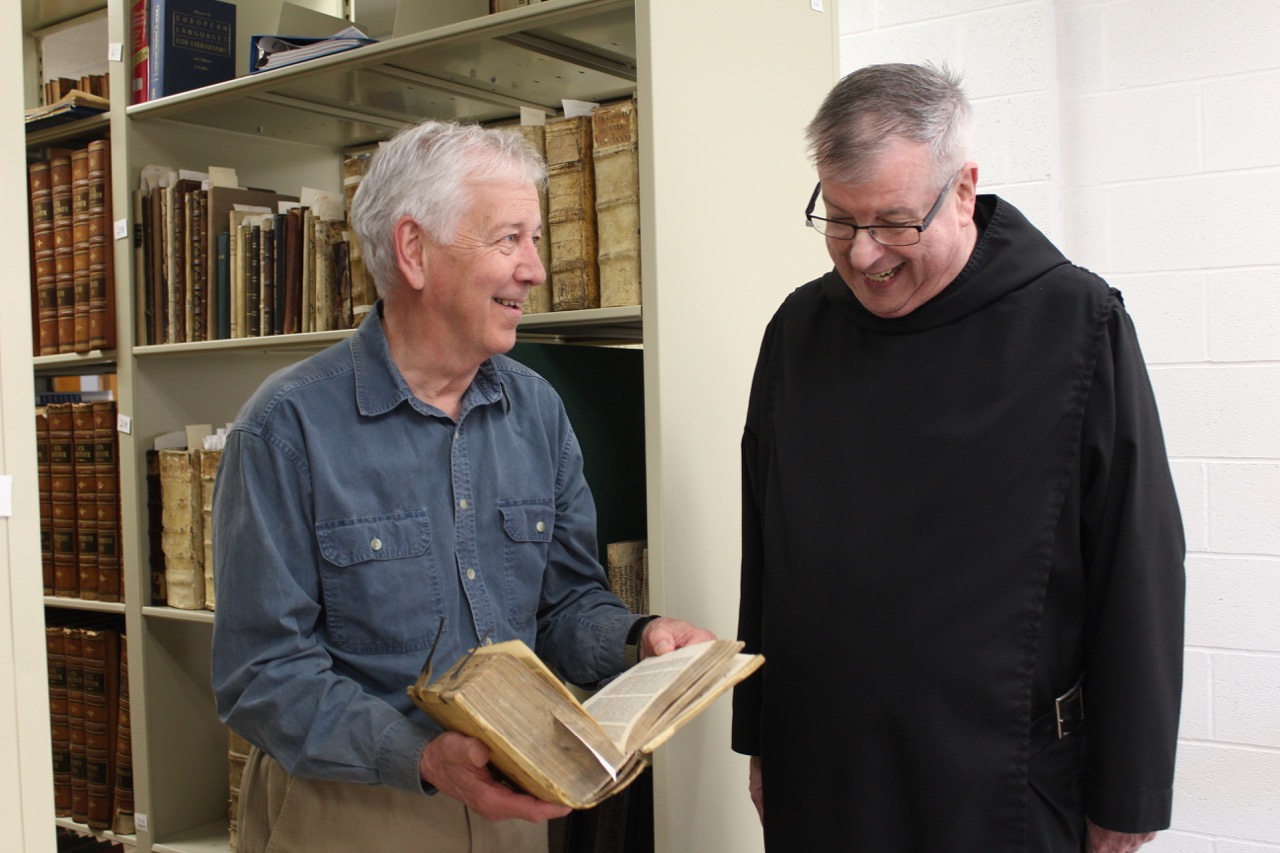
Conception’s fifteenth-century book collection attracts binding expert

Bookbinding Expert Scott Husby (left) shows Special Collections Librarian Br. Thomas Sullivan some of his findings at the close of his research visit at Conception Abbey and Seminary College.
Conception, Mo. – A floor above the Conception Abbey and Seminary College library’s extensive collection sits a small, well-lit “rare book room.”
The room houses around 3,000 unique and historical books, and among those is a small collection of 59 books from the 15th century. Books printed in Europe before 1501 are known as incunables. “Incunable” is the anglicized singular form of incunabula, Latin for “swaddling clothes” or “cradle.”
Collections of incunable books are especially of interest to conservator and bookbinder Scott Husby. Over the last 20 years, he has researched the bindings of 27,000 incunables in 30 libraries across the United States, including his former employer Princeton, along with Harvard, Yale, and the US Library of Congress, among others mostly along the coasts.
Printing began in the 15th century, which is also when binding “took off,” Scott explained. “Hundreds of thousands of books were printed, which is why binderies came into existence.”
Scott has found that about 20 percent of incunabula found in the United States have their original bindings, with about 5,000 of the books he has studied proving this point.
“It’s more like half here,” he noted. “Many of these didn’t go through a book trade, they came straight from Engelberg (Switzerland) to here.”
Conception Abbey was founded by the Benedictine monks of Engelberg in 1873. By 1880, the collection numbered 3,000 books.
Within the current collection brought over from the Abbey in Engelberg, many are still in their original bindings.
Special Collections Librarian Br. Thomas Sullivan, O.S.B., served as host to Scott during his time at the Abbey.
“Scott’s research gives us more information about the history and nature of our collection,” Br. Thomas explained. “These books, especially the Engelberg collection, explain Conception’s intellectual history.”
Br. Thomas compared Scott’s research of the Engelberg collection to database websites to understand a person’s genealogy.
“Down to the boards and cords, the binding is a real artisanal thing itself that tells us about the uses and owners of the books that gives us a great deal of insight into the collection.”
The monks at the Abbey in Engelberg sent about 25 books to Conception and 25 to Mount Angel in Oregon in the early years, with a list documenting those books.
Scott measures the books and looks for scribal decorations and stamps that might indicate where the book was originally bound. He has built a large database where he can compare stamps, rubbings, and other markings to allude to the books’ histories.
“Today, every book looks the same and goes through the same publishing process,” Scott said. “When printing first started, books were bound in a different location than where they were printed.”
The books were often bound wherever the new owner was, be it a monastery or otherwise. Because books were bound in a different location, this process allows Scott to get a glimpse into where these books traveled during the 15thcentury.
“In that period of early printing, it was rare to find two copies exactly the same,” he said. “Every book was a unique, individual entity.”
The information Scott gathers can indicate the price of the book, whether it was made for a wealthy owner, monastery, or scholar.
Scribal decorations within the books often made them even more unique, he noted. While a monastery would have requested a very simple product, a layperson might have paid a commission to have more scribal decoration added.
“I took rubbings of stamping on 10 books, probably from Switzerland, in some connection to the Abbey,” he said.
He found some to be very nice, with bindings still in good condition.
Scott’s original interest for studying incunabula began during his time as Princeton’s book conservator. He retired from that position in 2007 and then focused solely on his research project for the next 6 or 7 years, he said. The first two years were funded by a grant.
After that, he and his wife, Tracey Cullen, moved to Minnesota and his incunabula binding research came to a halt.
After not having studied any book spine binding recently, Conception Abbey was his first research venture of this nature in five years.
Scott heard about the Abbey’s collection while doing a study at the University of Missouri in Columbia. Someone at the University of Missouri – Kansas City told him about Conception Abbey as a small, religious institution had more than 50 incunabula. He said this piqued his interest immediately.
He and his wife, Tracey Cullen, stayed overnight at the Abbey Guest Center in late April, for his two-day research venture in the rare book room.
Scott’s wife Tracey, who is an archaeologist, enjoyed the scenery while Scott worked. She said she had never watched him do his work and was glad to have the opportunity here.
“What he is doing is fantastic,” Tracey said. “Ancient material culture projects reveal so much about their time.” She said they share a love for history and the knowledge they can gain from understanding it.
To learn more about the Conception Abbey and Seminary College’s rare book room, contact Br. Thomas at thomas@conception.edu. (Media requests should go through Kaity Holtman at kholtman@conception.edu.)
Posted in Monastery News
